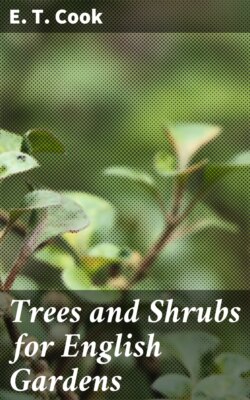Читать книгу Trees and Shrubs for English Gardens - E. T. Cook - Страница 38
На сайте Литреса книга снята с продажи.
WEEPING TREES AND THEIR USES
ОглавлениеTable of Contents
It is not at all easy to define special uses for trees of weeping habit, but it is safe to use them nearly singly and not in immediate connection with trees of quite upright form. The point in the weeping tree is a certain grace of drooping line, such as one enjoys in the drooping racemes of many of the papilionaceous flowers such as Wistaria, Laburnum, and Robinia. Nothing is gained by accentuating the peculiarity by a direct association with trees of an opposite way of growth. It is better rather to place the weeping trees near rounded masses of shrub and small tree—for example, a Weeping Birch would group well with a clump of Rhododendrons.
Near water weeping trees seem to be specially effective. An instance of this is shown in the familiar Weeping Willow, but one at a time seems as much as is wanted.
As a general rule, we strongly advocate planting in groups, whether in the case of trees, shrubs, or flowering plants, but the weeping trees are less suited for grouping than any others. One Weeping Willow is all very well, but a whole grove of them would be monotonous and tiresome.
ELÆAGNUS PUNGENS (Kew).
The habit of some of the weeping trees can be directly turned to account in the making of arbours and pergolas; for by planting the large-leaved Weeping Elm or the Weeping Ash at the back and on each side in the case of an arbour, or alternately on each side of the walk for a pergola, a living shelter may be made in a very few years. The trees in this case are standards pollarded at about 8 feet from the ground, the form in which they are generally sent out from the nursery.
CORNUS MAS VAR. VARIEGATA (Variegated Cornel).
Among evergreens the Holly is invaluable. As a rule the weeping or pendulous varieties are budded on tall stems of the type, and trained out in an umbrella-like fashion, thus forming a hollow mound of greenery. In some places, notably at Brookwood in Surrey, pendulous Hollies have been allowed to grow without any attempt at training. Stout stems 10 feet to 12 feet high are surmounted by irregular heads, which droop down 6 feet or 7 feet, leaving several feet at the base of the stem bare. In winter the long pendulous branches, smothered with bright red berries, are very pleasant. Facing page 248 is an illustration of a weeping Holly (I. Aquifolium var. pendula) at Kew. Of variegated weeping Hollies there are Argentea pendula (Perry's Weeping), with silver variegated leaves; aurea pendula (Waterer's Weeping), with gold variegated leaves; and pendula tricolor. To encourage height rather than width, it is often necessary to tie up a few of the top shoots, otherwise they get out of shape; they increase more quickly in width than height.
